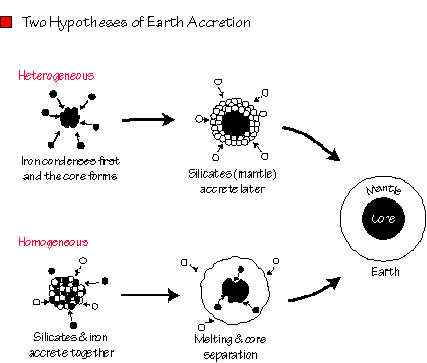Chapter 2, Earth: Origin and Composition - 05
The Formation of the Solar System
We want to know Earth's composition. What line of evidence can we use? We can use the laws of physics and chemistry to construct hypotheses of composition and Earth formation. What are the observations we have available?
During the approximately 10 billion following after the Big Bang, the Universe expanded, stars were created that later exploded in Nova or fizzled and cooled. Our Solar system is approximately 4.55 billion years old, so at first you may think that only a few stellar cycles could have taken place. However, our star is relatively small and much larger stars are possible. Larger stars burn their fuel more quickly, and can complete their "life" cycle in as little time as 10's of millions of years! So, there were many cycles of star formation -> Nova during the first two thirds of history.
Our solar system formed approximately 4.55 billion years ago, when a gas cloud produced from the Big Bang and prior Supernovae coalesced. We presume that the solar "nebula" (cloud) that later became our Solar System was initially rotating, not an unreasonable assumption since it was the result of a prior supernova. Eventually, the cloud succumbed to the forces of gravity and began to coalesce. Since it was spinning, the laws of gravity and conservation of angular momentum produced a spinning disk out of the nebula.
The Proto-Sun was concentrated at the center of the disk, and perhaps rings formed much like those around Saturn. These rings would later become the planets. Eventually, the gravitational collapse of the material ignited as fusion began in the Sun. The early Sun had a powerful solar wind that began to blow much of the light elements away from the inner parts of the disk.
This is the fundamental reason for the rocky inner planets and gaseous outer planets in our solar system. In the meantime, the planets formed by the aggregation of the nebular material remaining in the disk.

Note that both models produce a collection of iron-rich material at the center of the planet. This is by design, for we have strong evidence that the inner part of Earth is predominantly iron.
The Evidence:
A meteorite is a fragment of asteroid, comet, planet, or moon that have fallen to Earth.
An asteroid is a rocky/iron body that traverse the solar system. Most asteroids orbit in a planetary "gap" between Mars and Jupiter. They have characteristic diameters between a few to few-hundred kilometers.
A comet is a mass of water, carbon dioxide, ammonia, methane, and other gasses that orbit the Sun from very large distances (up to 1/5 the distance to the closest star).